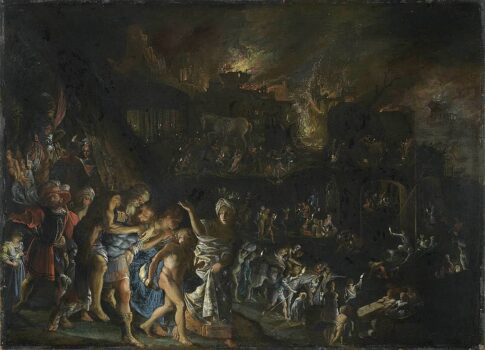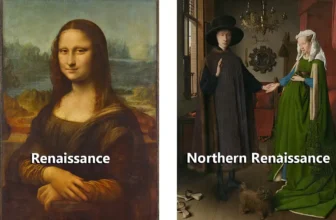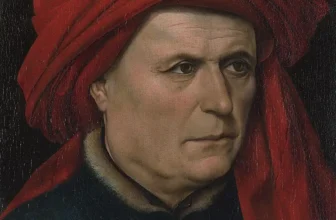Meaning of Adam Elsheimer’s The Burning of Troy Painting
Adam Elsheimer’s The Burning of Troy (German: Der Brand von Troja), ca. 1600–1601, is a compact yet masterful oil-on-copper painting (36 × 50 cm) in the Alte Pinakothek, Munich . This nocturnal scene, influenced by Jan Brueghel the Elder’s nightscapes, captures the climactic moment when Aeneas escapes the doomed city, carrying his elderly father Anchises on his back, accompanied by his wife Creusa and son Ascanius, all fleeing beneath a sky heavy with fire and smoke .
Who Was Adam Elsheimer?
Born in Frankfurt in 1578, Elsheimer trained in Venice before settling in Rome, where he became renowned for his small-scale, meticulously detailed paintings and gouaches. His innovative use of light, often along dramatic daylight-to-nighttime transitions, deeply influenced Baroque masters such as Rubens and Rembrandt. Sadly, Elsheimer died prematurely in Rome in December 1610, leaving behind around 30 surviving paintings, including this one, and several rare drawings and gouaches .
Subject and Composition
Inspired by classical myth, particularly Virgil’s Aeneid and Ovid’s Metamorphoses, the work centers on the Flight of Aeneas.
In the left foreground: the Aeneas family group, with Aeneas bearing his father’s weight carefully (even clutching his robe), his wife Creusa, and son Ascanius bringing up the rear .
The burning city lies behind them: columns aflame, the Trojan Horse ominously outlined against the fire, Greek ships visible in the distance .
A dramatic sky, deep blues and reddening smoke, casts flickering light and heavy shadows across the scene, heightening the emotional stakes.
Style & Technique
Oil on copper allowed Elsheimer to render fine detail and smooth gradations of light, yielding a jewel-like luminosity .
The nocturnal setting reveals his mastery of chiaroscuro, a dramatic play of light and dark that enhances the storytelling tension .
The panoramic architecture and flaming ruins exhibit his precision akin to Dutch landscapes and night scenes .
Symbolism & Meaning
Piety and Duty
Aeneas carrying his father symbolizes pietas, a Roman virtue denoting familial love, religious obligation, and loyalty, a moral ideal preserved among the collapsing values of Troy .Fate and Transition
The chaos of Troy’s destruction juxtaposed with Aeneas’s escape illustrates the destructive end of an era and the fated birth of a new civilization, Rome itself.Heroic Sacrifice
Every figure expresses endurance and urgency, the father carried, the wife beside him, and the son looking back, underscoring themes of widowhood, survival, and lineage.Light as Emotional Narrator
The fire and moonlight together become key storytellers: fire representing military conquest and catastrophe; moonlight suggesting hope and clarity amid ruin.Architectural Echoes
The ruins echo classical grandeur and religion, walls, temples, columns ablaze, emphasizing how human ambition, religion, and art were engulfed by war.
What’s Happening in the Scene?
Aeneas, head green-lit by the blaze, carries Anchises amid scattered Trojan survivors.
Creusa, identifiable in her flowing robes, trails and will soon vanish, a nod to her death (per Virgil), even if not depicted explicitly.
Ascanius’s placement signals continuation: Troy may fall, but Rome’s destiny persists.
The sky frames the chaos: a small moon lightening the scene, jets of fire flaring up from temple structures, while distant Greek vessels line the horizon.
Artistic Classification
Period: Early Baroque / late Mannerism, melding dramatic emotion with classical composure.
Technique: Oil on copper, a medium suited for Elsheimer’s luminous technique.
Genre: Mythological history painting, specifically a nocturne.
Influences: Dutch landscape painting, Roman classical tradition, and Brueghel’s nocturnal works.
Where Is It Today?
Since 1836, the painting has been in Munich’s Alte Pinakothek (Cabinet 13, 1st floor), accession number 205 .
Previously in the Mannheim Gallery (1756), acquired in 1799 by Munich’s collection, and transferred to the Pinakothek in its 1836 opening .
Why This Painting Matters
Scale and Detail: Despite its modest size, the painting is rich in narrative, technical brilliance, and emotional energy.
Influence: Elsheimer’s nocturnes and use of copper influenced European Baroque’s leading lights.
Thematic Sophistication: It celebrates Roman virtue and destiny during collapse, deeply resonant in Counter-Reformation and early Baroque cultural contexts.
Technical Innovation: His micro-painterly precision on copper, merging drawing and painting methods, foretells later landscape and night masterpiece traditions.
Related Works
Elsheimer’s gouache study Aeneas Saving Anchises from Burning Troy (c. 1600, gouache on paper) illustrates the same scene with a more intimate focus. Commissioned as an album amicorum piece, it incorporates precise pen drawing and color, demonstrating Elsheimer’s exploratory technique .
Other artists, such as Jan Brueghel the Elder, depicted the catastrophic final hours of Troy earlier, with notable influence on Elsheimer .
Concluding Reflections
Elsheimer’s The Burning of Troy acts as a microcosm of tragedy, morality, and survival, showing how classical narrative and technical prowess inform each other. In the intimacy of copper, we see a vast, fiery tableau, humans caught between heritage and destiny. Aeneas, embodying pietas and hope, bears the weight of both his father and his future civilization.
Visiting Munich? Seek this treasure in the Alte Pinakothek and examine its scale, composition, and luminance firsthand.
Summary Table
| Feature | Description |
|---|---|
| Artist | Adam Elsheimer (German‑Italian Baroque pioneer) |
| Date | ca. 1600–1601 |
| Medium | Oil on copper, 36 × 50 cm |
| Location | Alte Pinakothek, Munich (Cabinet 13) |
| Subject | Aeneas fleeing burning Troy with family |
| Themes | Pietas, fate, transition, sacrifice |
| Symbolism | Fire, moonlight, architecture, family |
| Style | Baroque mythological nocturne rich in chiaroscuro |
| Influences | Brueghel, Raphael, Northern and Italian traditions |
| Legacy | Influenced Baroque lighting; admired by Rubens, Rembrandt |
Elsheimer’s dramatic nocturnal light, compact grandeur, and poignant narrative create a painting that transcends mere depiction, offering an emotional gateway to classical memory and Baroque sensibility.




